23.2 Organizing Documents
Because documents are stored in a database structure, information can be associated with each document that is not part of the document itself. This additional information is stored as document properties.
NOTE:Document properties cannot be set in ConsoleOne on Linux. However, you can use ConsoleOne on Windows to set document properties for libraries that are located on Linux.
23.2.1 Customizing Document Properties
For a summary of document properties, see Section 21.3.1, Document Properties. To review, the following document properties are provided by default:
- Author
- Creator
- Current Version Number
- Date Created
- Document Number
- Document Type
- Official Version Number
- Subject
The default document property types cannot be deleted. Except for the Document Type property, they cannot be modified. However, you can add custom document types as needed.
Customizing the Default Document Type Property
The Document Type property is the only default document property that you can modify. For a review of document types, see Section 21.3.2, Document Types. You must have at least one document type, because it is a required document property field.
To modify the Document Type property for all libraries in a post office:
-
In ConsoleOne on Windows, browse to and select the post office that has libraries where you want to modify the Document Type property.
-
Click > > .
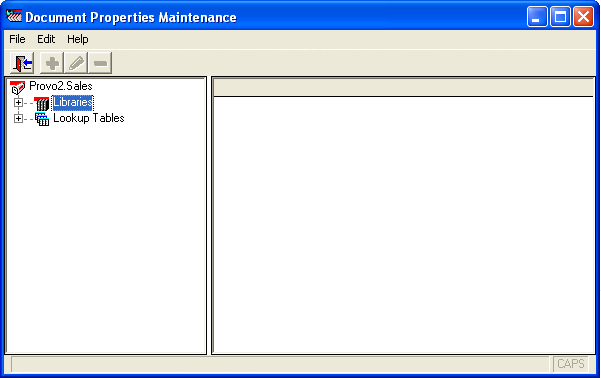
If you expand Libraries and select each library, you see that each library has the Document Type property. It is required.
-
Expand Lookup Tables, then select .
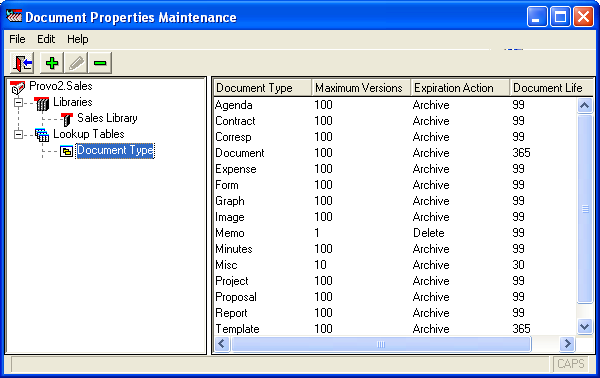
The lookup table defines the list of choices offered to users when they select a document type, no matter which library in the post office they are creating the document in.
-
To add a new document type, click > . In the field, type the new document type, click , then click .
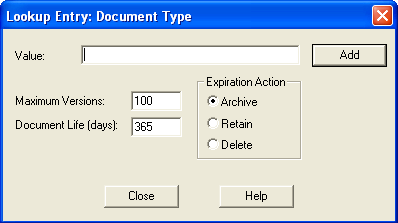
-
To edit an existing document type, click > . Change the settings as needed, click , then click .
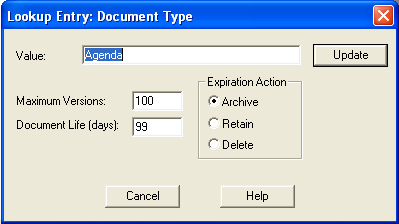
For more details about the fields associated with the Document Type property, see Section 21.3.2, Document Types.
-
To delete a document type, select the document type, click , then click .
Planning Custom Document Properties
When you need to add custom document properties, print the Custom Document Properties Worksheet. One copy of the worksheet accommodates three new document properties.
The following table describes the fields and values associated with custom document properties:
Table 23-1 Document Properties
|
Document Property Field |
Field Values |
|---|---|
|
Field: |
The document property field is the label that GroupWise client users see in the document Properties dialog box. When you create a new document property, you can provide a description as well. However, the description displays only in ConsoleOne, not in the GroupWise client. |
|
|
Yes: The document property field displays information, but it is not accessible to users. No: Users can type in the document property field. |
|
|
Yes: The user must supply a value for the document property. No: The user can leave the document property field blank. |
|
|
Yes: The document property field is not displayed in the GroupWise client interface. No: The document property field is displayed in the GroupWise client interface. |
|
|
A lookup table is required for a custom document property only when you want to offer the user a list of choices, rather than having the user type in the setting. The lookup table guarantees that the user provides a valid setting. For more information, see Planning Custom Lookup Tables for Custom Document Properties. |
|
|
A related property is required for a custom document property only when you create a lookup table that references a related lookup table. For more information, see Section 23.2.2, Defining Related Document Properties. |
|
|
Binary: An Object API reads and writes this information Date: Displayed in the Windows format selected by the user Number: Numerical only String: Alphanumeric |
|
|
For the String data type, you can specify the maximum number of characters allowed in the string. The longest possible string is 65535 alphanumeric characters. |
|
|
For the String data type, you can control how the user’s input is handled: Upper: Forces entries to display in uppercase Lower: Forces entries to display in lowercase Mixed: Allows alphabetical characters to be displayed as typed |
|
|
For the Number data type, you can specify a minimum acceptable value. |
|
|
For the Number data type, you can specify a maximum acceptable value. |
|
|
If the new document property is related to an existing document property in a parent-child relationship, you must specify the parent document property. For more information, see Section 23.2.2, Defining Related Document Properties. |
Use copies of the Custom Document Properties Worksheet to plan the custom document properties you want to add to libraries.
If you need to create one or more lookup tables for your custom document properties, follow the instructions in Planning Custom Lookup Tables for Custom Document Properties and Adding Custom Lookup Tables. Lookup tables used by new document properties should exist before you create custom document properties.
Then continue with Adding Custom Document Properties.
Custom Document Properties Worksheet
For instructions on how to use this worksheet, see Planning Custom Document Properties.
|
Item |
Custom Document Property |
Custom Document Property |
Custom Document Property |
|---|---|---|---|
|
1) Post Office: |
|||
|
2) Libraries: |
|||
|
3) Property Label: |
|||
|
4) Description: |
|||
|
5) Read-Only?
|
|||
|
6) Required?
|
|||
|
7) Hidden?
|
|||
|
8) Lookup Table: |
|||
|
9) Data Type:
|
|||
|
10) Maximum Length: |
|||
|
11) Case:
|
|||
|
12) Minimum Value: |
|||
|
13) Maximum Value: |
|||
|
14) Parent: |
Adding Custom Document Properties
After you have determined what new document properties will meet the needs of your DMS system, as described in Planning Custom Document Properties, and if necessary you have created lookup tables for your new document properties, as described in Planning Custom Lookup Tables for Custom Document Properties and Adding Custom Lookup Tables, you are ready to add new custom document properties.
To add new custom document properties:
-
In ConsoleOne on Windows, browse to and select the Post Office object that owns the library for which you are creating custom document properties (worksheet item 1).
-
Click > > .

-
Expand Libraries, then select the library for which you are creating custom document properties (worksheet item 2).
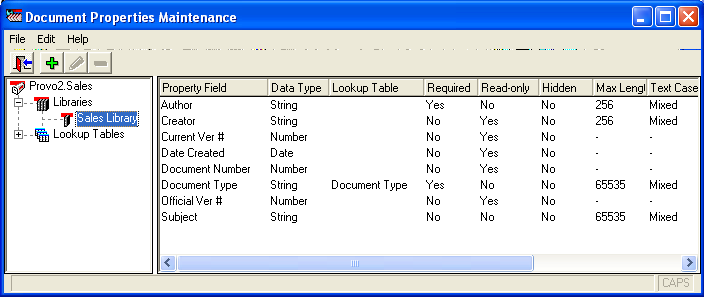
-
Click > to display the Document Property Definition dialog box.
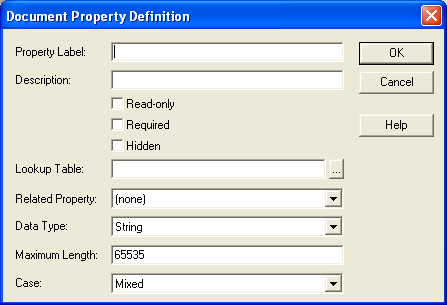
Fields vary according to data type.
-
Fill in the fields (worksheet items 3 through 14).
-
Click to create the new custom document property.
In the Document Properties Maintenance window, the new document property is listed in alphabetical order. In the GroupWise client, custom document properties are listed after default document properties, in the order in which they are added to the library.
-
Repeat Step 4 through Step 6 for each new custom document property.
When users next create documents in the library, the new custom document properties will be available to them.
Planning Custom Lookup Tables for Custom Document Properties
A lookup table is required for a custom document property only when you want to offer the user a list of choices, rather than having the user type in the setting. The lookup table guarantees that the user provides a valid setting.
Lookup tables are defined for the post office, so that multiple libraries in the post office can reference the same lookup tables.
When you need to provide lookup tables for custom document properties, print the Custom Lookup Tables Worksheet. One copy of the worksheet accommodates three new lookup tables.
The following table describes the fields and values associated with lookup tables:
Table 23-2 Lookup Table Values
|
Look Up Table Field |
Field Values |
|---|---|
|
|
The lookup table name identifies the lookup table when you are assigning it to a property field. If the lookup table pertains to only one document property, you can name the lookup table the same as the document property. For example, the default property Document Type uses a lookup table named Document Type. However, lookup tables can be used by multiple document properties. For example, you could have a lookup table named Project used by document properties named Primary Project and Secondary Project. When you create a new lookup table, you can provide a description as well. If the lookup table name does not match a document property, you could indicate what document properties use the lookup table. |
|
|
A related table is required for a lookup table only when you want to define related properties. For more information, see Section 23.2.2, Defining Related Document Properties. |
|
|
Binary: An Object API reads and writes this information Date: Displayed in the Windows format selected by the user Number: Numerical only String: Alphanumeric |
|
|
For the String data type, you can specify the maximum number of characters allowed in the string. The longest possible string is 65535 alphanumeric characters. |
|
|
For the String data type, you can control how the user’s input is handled: Upper: Forces entries to display in uppercase Lower: Forces entries to display in lowercase Mixed: Allows alphabetical characters to be displayed as typed |
|
|
For the Number data type, you can specify a minimum acceptable value. |
|
|
For the Number data type, you can specify a maximum acceptable value. |
|
|
The lookup table entries are the settings that users will choose from when they set the custom document property. |
Use copies of the Custom Lookup Tables Worksheet to plan the lookup tables you need in order to provide values for new custom document properties. If you need to use related properties, follow the instructions in Section 23.2.2, Defining Related Document Properties. Then continue with Adding Custom Lookup Tables.
Custom Lookup Tables Worksheet
For instructions on how to use this worksheet, see Planning Custom Lookup Tables for Custom Document Properties.
|
Item |
Custom Lookup Table |
Custom Lookup Table |
Custom Lookup Table |
|---|---|---|---|
|
1) Post Office: |
|||
|
2) Property Label: |
|||
|
3) Lookup Table Name: |
|||
|
4) Description: |
|||
|
5) Related Table: |
|||
|
6) Data Type:
|
|||
|
7) Maximum Length: |
|||
|
8) Case:
|
|||
|
9) Minimum Value: |
|||
|
10) Maximum Value: |
|||
|
11) Lookup Table Entries: |
Adding Custom Lookup Tables
After you have determined what new lookup tables and lookup table entries you need to accommodate your new custom document properties, as described in Planning Custom Lookup Tables for Custom Document Properties, you are ready to add new lookup tables.
-
In ConsoleOne on Windows, browse to and select the Post Office object that owns the libraries for which you are creating lookup tables (worksheet item 1).
-
Click > >

-
Select , then click > to display the Lookup Table Definition dialog box.
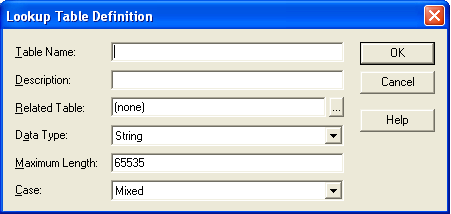
Fields vary depending on data type.
-
Fill in the fields (worksheet items 3 through 10).
-
Click to create the new lookup table.
-
Select the new lookup table, then click > to display the Lookup Entry dialog box.
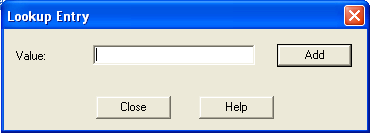
-
In the field, type one of the document property settings you want to offer to users (worksheet item 11), then click .
-
Repeat Step 7 for all the lookup table entries listed on your worksheet for this lookup table, then click .
-
Click to create the custom lookup table.
23.2.2 Defining Related Document Properties
When document properties are related, your choice for the first property determines the settings you are offered for the second property. The user’s selection in the first field determines what choices were offered in the second field.
Related document properties are set up by creating related lookup tables. Complete the following tasks to set up related document properties:
Planning Related Document Properties
Related document properties use a parent-child relationship. A parent property can have multiple child properties, but a child property can belong to only one parent. The relationship can include only two levels. A parent property cannot function as a child and a child property cannot function as a parent. The default document properties cannot participate as related properties.
In the Development Library example above, the Product document property would be the parent property and the Component document property would be the child property. If the Development Library belonged to Novell, products would include GroupWise, NetWare, ZENworks, and so on. When users selected GroupWise as the product, listed components could include the GroupWise client, the agents, GroupWise system administration, and so on. Or you could let users type in whatever components they wanted.
When you need to set up related document properties, print the Related Document Properties Worksheet. One copy of the worksheet accommodates one pair of related property fields, one parent lookup table, and one child lookup table (optional).
The following table describes the document properties and lookup tables that are required in order to set up related document properties:
Table 23-3 Document Properties and Lookup Tables
|
Properties and Tables |
Description |
|---|---|
|
Parent Document Property |
The parent document property is the user’s first selection. In the Development Library example above, the parent document property is Product. |
|
Child Document Property |
The child document property is the user’s second selection, based on the first selection. In the Development Library example above, the child document property is Component. |
|
Parent Lookup Table |
The entries in the parent lookup table provide the choices offered to the user in the parent document property field. In the Development Library example above, the user could select from GroupWise, NetWare, and ZENworks in the Product field. |
|
Child Lookup Table |
The entries in the child lookup table provide the choices offered to the user after a choice from the parent lookup table has been selected. In the Development Library example above, if the user selected GroupWise in the Product field, the child lookup table would provide choices such as Agents, Client, and Admin in the Component field. The child lookup table is not required if you want to allow the user to type in anything they want in the child document property field. |
Use copies of the Related Document Properties Worksheet to plan the related document properties you want to use. One copy of the worksheet accommodates one pair of related properties. Continuing with the Development Library example, a filled-in worksheet might look like this:
Table 23-4 Sample Document Properties Worksheet
|
Item |
Setting |
Item |
Setting |
|---|---|---|---|
|
1) Parent Document Property |
Property Name: Product |
4) Child Document Property |
Property Name: Component |
|
2) Parent Lookup Table |
Table Name: Product |
5) Child Lookup Table |
Table Name: Component |
|
3) Parent Lookup Entries |
(required) |
6) Child Lookup Entries |
(optional) |
|
Parent Entry: GroupWise |
Child Entries: Admin Agents Client |
||
|
Parent Entry: NetWare |
Child Entries: Client eDirectory Servers |
||
|
Parent Entry: ZENworks |
Child Entries: Desktops Servers |
When you have finished planning related properties and their associated lookup tables, you should print and fill in a worksheet for each for each new related property, as described in Planning Custom Document Properties, and for each new lookup table, as described in Planning Custom Lookup Tables for Custom Document Properties.
Then you are ready to continue with Creating Related Lookup Tables.
Related Document Properties Worksheet
For instructions on how to use this worksheet, see Planning Related Document Properties.
|
Item |
Setting |
Item |
Setting |
|---|---|---|---|
|
1) Parent Document Property |
Name: |
4) Child Document Property |
Name: |
|
2) Parent Lookup Table |
Name: |
5) Child Lookup Table |
Name: |
|
3) Parent Lookup Entries |
(required) |
6) Child Lookup Entries |
(optional) |
|
Entry: |
Entries: |
||
|
Entry: |
Entries: |
||
|
Entry: |
Entries: |
Creating Related Lookup Tables
If you are supplying the choices for both related fields, you need both a parent lookup table and a child lookup table. If you are going to have users type information into the child property field, then you only need to create the parent lookup table. You should create lookup tables before creating the document properties that use them.
Creating the Parent Lookup Table
-
Create a new lookup table, as described in Step 1 through Step 5 in Adding Custom Lookup Tables. Use worksheet item 2 in the Table Name field. Leave the Related Table field set to (none).
-
Add entries to the new lookup table, as described in Step 6 through Step 8 in Adding Custom Lookup Tables. Use the entries listed under worksheet item 3 in the Value field.
-
Continue with Creating the Child Lookup Table (Optional).
or
If you are going to have users type information into the child property field, rather than selecting from a predefined list, skip to Setting Up Related Document Properties
Creating the Child Lookup Table (Optional)
-
Create a new lookup table, as described in Step 1 through Step 5 in Adding Custom Lookup Tables. Use worksheet item 5 in the Table Name field. Use worksheet item 2 in the Related Table field to link the child table to the parent table.
-
Select the new lookup table, click , then click to display the Lookup Entry dialog box.
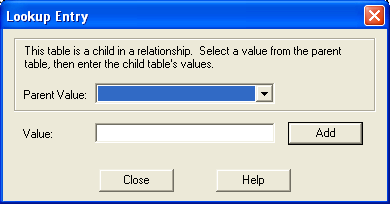
-
Select a Parent value.
-
In the field, type one of the child lookup table entries for the selected parent value (worksheet item 6), then click .
-
Repeat Step 4 for each entry listed under worksheet item 6.
-
Repeat Step 3 through Step 5 for each parent value listed under worksheet item 3.
-
Continue with Setting Up Related Document Properties.
Setting Up Related Document Properties
After you have created related lookup tables, you are ready to set up the related document properties that use them. A few document property fields are required settings in the context of related properties:
-
must be set to No.
-
must be set to No.
-
must be set the same on the child property as it is on the parent property.
To set up related document properties:
-
Create the parent document property as described in Adding Custom Document Properties. Use worksheet item 1 in the Property Label field. Use worksheet item 2 in the Lookup Table field. Leave the Related Property field set to (none).
-
Create the child document property using the same procedure. Use worksheet item 4 in the Property Label field. Use worksheet item 5 in the Lookup Table field. The Related Property field should automatically display as worksheet item 1, showing that the child property is related to the parent property.